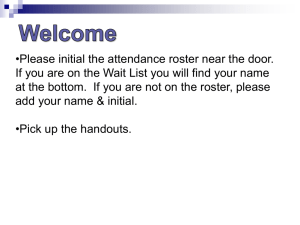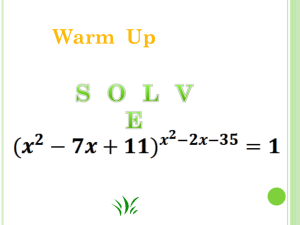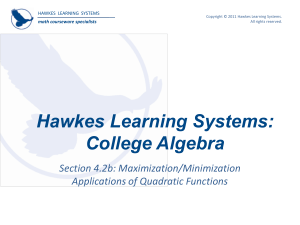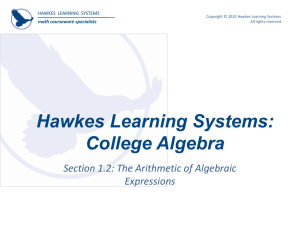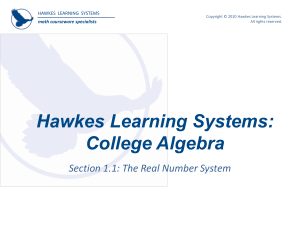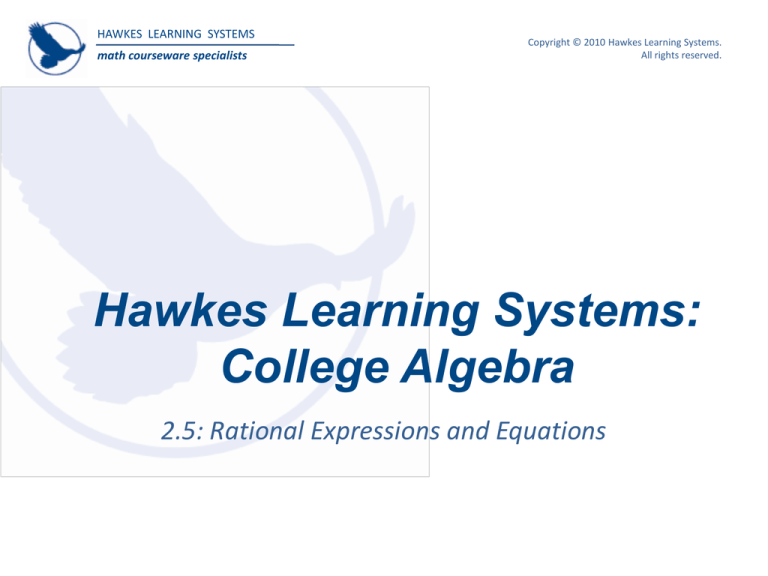
HAWKES LEARNING SYSTEMS
math courseware specialists
Copyright © 2010 Hawkes Learning Systems.
All rights reserved.
Hawkes Learning Systems:
College Algebra
2.5: Rational Expressions and Equations
HAWKES LEARNING SYSTEMS
Copyright © 2010 Hawkes Learning Systems.
All rights reserved.
math courseware specialists
Objectives
o Simplifying rational expressions.
o Combining rational expressions.
o Simplifying complex rational expressions.
o Solving rational equations.
o Interlude: work-rate problems.
HAWKES LEARNING SYSTEMS
math courseware specialists
Copyright © 2010 Hawkes Learning Systems.
All rights reserved.
Simplifying Rational Expressions
A rational expression is an expression that can be
written as a ratio of two polynomials
P
. Of course,
Q
such a fraction is undefined for many value(s) of the
variable(s) for which Q 0 . A given rational
expression is simplified or reduced when P and Q
contain no common factors (other than 1 and 1).
x2
x2 x 1
,
Ex:
x 1
x
HAWKES LEARNING SYSTEMS
math courseware specialists
Copyright © 2010 Hawkes Learning Systems.
All rights reserved.
Simplifying Rational Expressions
o To simplify rational expressions, we factor the
polynomials in the numerator and denominator
completely, and cancel any common factors.
o However, the simplified rational expression may be
defined for values of the variable(s) that the original
expression is not, and the two versions are equal
only where they are both defined. That is, if A , B
and C represent algebraic expressions,
AC A
only where B 0 and C 0.
BC B
HAWKES LEARNING SYSTEMS
math courseware specialists
Copyright © 2010 Hawkes Learning Systems.
All rights reserved.
Example 1: Simplifying Rational Expressions
Simplify the rational expression, and indicate values of
the variable that must be excluded. 3
x 27
x 2 3x
Step 1: Factor both
polynomials.
x 3 x 2 3 x 9
Step 2: Cancel common
x x 3
factors.
x 2 3x 9
, x 0,3
x
Note: The final expression is defined only where both
the simplified and original expressions are defined.
HAWKES LEARNING SYSTEMS
Copyright © 2010 Hawkes Learning Systems.
All rights reserved.
math courseware specialists
Example 2: Simplifying Rational Expressions
Simplify the rational expression, and indicate values of
the variable that must be excluded.
x 2 2 x 15
5 x
x 3 x 5
x 5
x3
1
x 3, x 5
HAWKES LEARNING SYSTEMS
Copyright © 2010 Hawkes Learning Systems.
All rights reserved.
math courseware specialists
Simplifying Rational Expressions
Caution!
Remember that only common factors can be cancelled!
A very common error is to think is to think that
common terms from the numerator and denominator
x4 4
can be cancelled. For instance, the statement 2
x
x
x4
is incorrect.
is already simplified as far as
2
x
possible.
HAWKES LEARNING SYSTEMS
math courseware specialists
Copyright © 2010 Hawkes Learning Systems.
All rights reserved.
Combining Rational Expressions
o To add or subtract two rational expressions, a
common denominator must first be found.
o To multiply two rational expressions, the two
numerators are multiplied and the two denominators
are multiplied.
o To divide one rational expression by another, the first
is multiplied by the reciprocal of the second.
o No matter which operation is being considered, it is
generally best to factor all the numerators and
denominators before combining rational expressions.
HAWKES LEARNING SYSTEMS
Copyright © 2010 Hawkes Learning Systems.
All rights reserved.
math courseware specialists
Example 3: Combining Rational Expressions
Subtract the rational expression.
5x 2
2x
x2 5x 6 x2 4
5x 2
2x
x 2 x 3 x 2 x 2
x 2
x 3
5x 2
2x
x 2 x 2 x 3 x 3 x 2 x 2
5x2 8x 4
2 x2 6 x
x 2 x 2 x 3 x 2 x 2 x 3
3x 2 14 x 4
,
x 2 x 2 x 3
x 2, 2, 3
Step 1: Factor both
denominators.
Step 2: Multiply to
obtain the least
common
denominator
(LCD) and solve.
HAWKES LEARNING SYSTEMS
math courseware specialists
Copyright © 2010 Hawkes Learning Systems.
All rights reserved.
Example 4: Combining Rational Expressions
Add and subtract the rational expressions.
x 3 x 2 x 6 2 x 2 x 10
2
x 4 x x 12
x 2 16
x 3 x 3 x 2 2 x 2 x 10
x 4 x 4 x 3 x 4 x 4
x 4 x 3 x 4 x 2 2 x2 x 10
x 4 x 4 x 4 x 4 x 4 x 4
2 x 2 x 20 2 x 2 x 10
2
x 16
x 2 16
10
2
, x 4, 3,4
x 16
HAWKES LEARNING SYSTEMS
math courseware specialists
Copyright © 2010 Hawkes Learning Systems.
All rights reserved.
Example 5: Combining Rational Expressions
Multiply the rational expression.
x2 2 x 3
x2
2
x2
x 3x 4
x 3 x 1 x 2
x 2 x 1 x 4
x 3 x 1 x 2
x 2 x 1 x 4
x 3 x 2
, x 4, 2,1
x 2 x 4
HAWKES LEARNING SYSTEMS
Copyright © 2010 Hawkes Learning Systems.
All rights reserved.
math courseware specialists
Example 6: Combining Rational Expressions
Divide the rational expression.
x 2 x 20 x 2 10 x 25
2x
6 x3
x 4 x 5
2x
3
6 x3
x 5
2
6 x x 4 x 5
3
2 x x 5
3x 2 x 4
x 5
2
, x 0,5
2
HAWKES LEARNING SYSTEMS
Copyright © 2010 Hawkes Learning Systems.
All rights reserved.
math courseware specialists
Simplifying Complex Rational Expressions
o A complex rational expression is a fraction in which
the numerator or denominator (or both) contains at
least one rational expression. For example,
x 1 y 1
x
or
1
x5
y
o Complex rational expressions can always be
rewritten as simple rational expressions.
o One way to do this is to multiply the numerator and
denominator by the least common denominator
(LCD) of all the fractions that make up the complex
rational expression.
HAWKES LEARNING SYSTEMS
Copyright © 2010 Hawkes Learning Systems.
All rights reserved.
math courseware specialists
Example 7: Complex Rational Expressions
Simplify the complex rational expression.
Step 1: Multiply the numerator
and the denominator by
the LCD x z x .
Step 2: Cancel the common
factor of z.
1
1
xz x
z
1
1
x z x
x
z
x
z
x z x
1
x x z
z x z x
z
z x z x
1
, x 0, z 0, x z 0
xx z
HAWKES LEARNING SYSTEMS
Copyright © 2010 Hawkes Learning Systems.
All rights reserved.
math courseware specialists
Example 8: Complex Rational Expressions
Simplify the complex rational expression.
1 1
1
1
x y
x y x2 y2
2 2
2
2
1
1
x y
x y
x2 y 2
xy 2 x 2 y
2
y x2
xy y x
y x y x
xy
, x 0, y 0, y x 0, y x 0
yx
HAWKES LEARNING SYSTEMS
math courseware specialists
Copyright © 2010 Hawkes Learning Systems.
All rights reserved.
Solving Rational Equations
o A rational equation is an equation that contains at
least one rational expression, while any non-rational
expressions are polynomials.
o To solve these, we multiply each term in the
equation by the LCD of all the rational expressions.
This converts rational expressions into polynomials,
which we already know how to solve.
o However, values for which rational expressions in a
rational equation are not defined must be excluded
from the solution set.
HAWKES LEARNING SYSTEMS
math courseware specialists
Copyright © 2010 Hawkes Learning Systems.
All rights reserved.
Example 9: Solving Rational Equations
Solve the rational equation.
x3 6 x 2
2 x 8
2
x 4 x 12
x2
Step 1: Factor the numerators
and denominators, and
cancel common factors.
x2 x 6
Step 2: Multiply both sides by
the LCD.
2 x 8
x 2 x 6 x 2
x2
2 x 8
x 2
x 2
x 2
x 2
x2 2 x 8
x2 2 x 8 0
Step 3: Solve by factoring.
Note: 2 cannot be a solution.
x 2 x 4 0
x 2, 4
HAWKES LEARNING SYSTEMS
Copyright © 2010 Hawkes Learning Systems.
All rights reserved.
math courseware specialists
Example 10: Solving Rational Equations
2
2
x
Solve the rational equation.
1 0
4x 1
2 x2
1 0
4 x 1
4x 1
2x 4x 1 0
2
x
4 42 4 2 1
2 2
2 2
x
2
HAWKES LEARNING SYSTEMS
math courseware specialists
Copyright © 2010 Hawkes Learning Systems.
All rights reserved.
Interlude: Work-Rate Problems
o In a work-rate problem, two or more “workers” are
acting in unison to complete a task.
o The goal in a work-rate problem is usually to
determine how fast the task at hand can be
completed, either by the workers together or by one
worker alone.
HAWKES LEARNING SYSTEMS
Copyright © 2010 Hawkes Learning Systems.
All rights reserved.
math courseware specialists
Interlude: Work-Rate Problems
There are two keys to solving a work-rate problem:
1. The rate of work is the reciprocal of the time
needed to complete the task. If a given job can be done
by a worker in x units of time, the worker works at a
rate of 1 jobs per unit of time.
x
2. Rates of work are “additive”. This means that two
workers working together on the same task have a
combined rate of work that is the sum of their
individual rates.
Rate 1
Rate 2
Rate Together
1
1
1
Time 1
Time 2
Time Together
HAWKES LEARNING SYSTEMS
math courseware specialists
Copyright © 2010 Hawkes Learning Systems.
All rights reserved.
Example 11: Work-Rate Problem
One hose can fill a swimming pool in 10 hours. The owner buys a
second hose that can fill the pool in half the time of the first one.
If both hoses are used together, how long does it take to fill the
pool?
1
The work rate of the first hose is
10
1
The work rate of the second hose is
5
1 1 1
Step 1: Set up the problem.
10 5 x
Step 2: Multiply both sides by the
x 2 x 10
LCD 10x , and solve.
3 x 10
1
x 3 hours
3
HAWKES LEARNING SYSTEMS
math courseware specialists
Copyright © 2010 Hawkes Learning Systems.
All rights reserved.
Example 12: Work-Rate Problems
The pool owner from the last example fills his empty pool with
the two hoses, but accidentally turns on the pump that drains
the pool also. The pump rate is slower than the combined rate of
the two hoses, and the pool fills anyway, but it takes 20 hours to
do so. At what rate can the pump empty the pool?
1
1 1
10 x 20
3
6 x 20 x
5 x 20
x4


